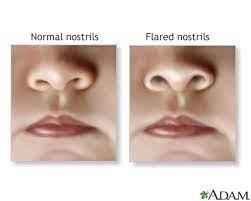A nurse is assessing a newborn following a vaginal delivery. Which of the following findings should the nurse report to the provider?

Heart rate 136/min
Nasal flaring
Transient strabismus
Overlapping of sutures
The Correct Answer is B
- A. Heart rate 136/min is a normal finding for a newborn. The normal range of heart rate for a newborn is 100 to 160/min.
- B. Nasal flaring is an abnormal finding for a newborn. Nasal flaring indicates respiratory distress and may be caused by conditions such as pneumonia, meconium aspiration, or congenital heart defects.
- C. Transient strabismus is a normal finding for a newborn. Transient strabismus is a temporary misalignment of the eyes that occurs due to weak eye muscles and poor coordination. It usually resolves by 3 to 6 months of age.
- D. Overlapping of sutures is a normal finding for a newborn. Overlapping of sutures is caused by molding of the skull during delivery and allows the head to fit through the birth canal. It usually resolves within a few days after birth.
Nursing Test Bank
Naxlex Comprehensive Predictor Exams
Related Questions
Correct Answer is C
Explanation
- A. Encourage the client to take a cool sponge bath each morning is not correct because it can increase joint stiffness and pain.
- B. Administer opioid analgesia is not correct because it is not the first-line treatment for rheumatoid arthritis and can cause dependence and tolerance.
- C. Increase the client's dietary iron intake is indicate in rheumatoid arthritis due to anemia of chronic inflammation.
- D. Restrict the client's intake of foods high in purines is incorrect in rheumatoid. It is an important measure in gouty arthritis.
Correct Answer is B
Explanation
Aspirate contents from the tube and verify the pH level.
- A. This is an incorrect action. Inserting air in the tube and listening for gurgling sounds in the epigastric area is not a reliable method to confirm NG tube placement, as it can produce falsepositive results due to air entering the stomach or intestines.
- B. This is a correct action. Aspirating contents from the tube and verifying the pH level is a valid method to confirm NG tube placement, as gastric contents typically have a pH of less than 5.5, while intestinal or respiratory contents have a higher pH.
- C. This is an incorrect action. Reviewing the medical record for previous x-ray verification of placement is not sufficient to confirm NG tube placement, as the tube can migrate or become dislodged after insertion. X-ray verification should be done initially and whenever there is doubt about the tube's position.
- D. This is an incorrect action. Auscultating the lungs for adventitious breath sounds is not a specific method to confirm NG tube placement, as it can indicate other conditions such as pneumonia or pulmonary edema. It can also miss signs of respiratory complications due to NG tube misplacement, such as pneumothorax or bronchial obstruction.
Whether you are a student looking to ace your exams or a practicing nurse seeking to enhance your expertise , our nursing education contents will empower you with the confidence and competence to make a difference in the lives of patients and become a respected leader in the healthcare field.
Visit Naxlex, invest in your future and unlock endless possibilities with our unparalleled nursing education contents today
Report Wrong Answer on the Current Question
Do you disagree with the answer? If yes, what is your expected answer? Explain.
Kindly be descriptive with the issue you are facing.
